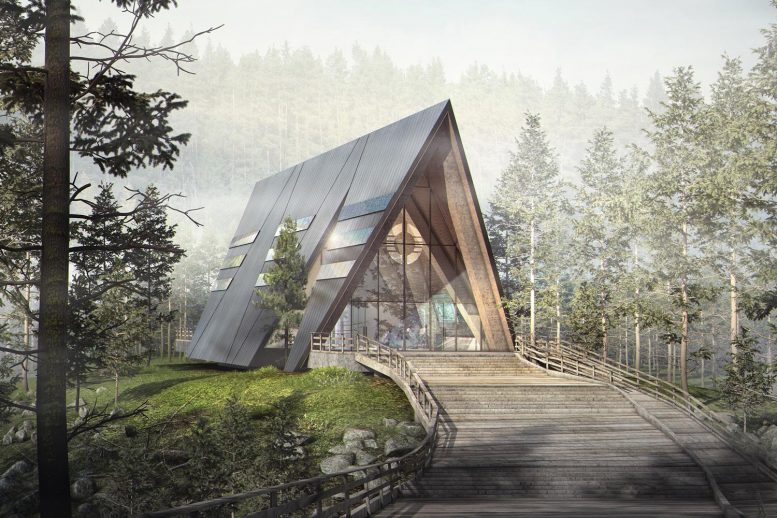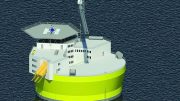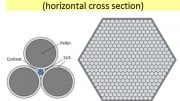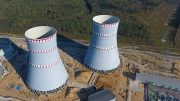
A rendering of Oklo’s first nuclear power plant, dubbed the Aurora, that will be built at the Idaho National Laboratory. Credit: Courtesy of Oklo
Oklo’s team is using a startup mindset to build novel reactors while meeting federal regulations.
All of the nuclear power plants operating in the U.S. today were built using the same general formula. For one thing, companies made their reactors big, with power capacities measured in the hundreds of megawatts. They also relied heavily on funding from the federal government, which through large grants and lengthy application processes has dictated many aspects of nuclear plant design and development.
That landscape has had varying degrees of success over the years, but it’s never been particularly inviting for new companies interested in deploying unique technologies.
Now the startup Oklo is forging a new path to building innovative nuclear power plants that meet federal safety regulations. Earlier this year, the company became the first to get its application for an advanced nuclear reactor accepted by the U.S. Nuclear Regulatory Commission (NRC). The acceptance was the culmination of a novel application process that set a number of milestones in the industry, and it has positioned Oklo to build an advanced reactor that differs in several important ways from the nuclear power plants currently operating in the country.
Conventional reactors use moderators like water to slow neutrons down before they split, or fission, uranium and plutonium atoms. Oklo’s reactors won’t use moderators, enabling the construction of much smaller plants and allowing neutrons to move faster.
Faster-moving neutrons can sustain nuclear fission with a different type of fuel. Compared to traditional reactors, Oklo’s fuel source will be enriched with a much higher concentration of the uranium-235 isotope, which fissions more easily than the more common uranium-238. The added proportion of uranium-235 allows Oklo’s reactor to run for longer time periods without having to refuel.
As a result of these differences, Oklo’s powerhouses will bear little resemblance to conventional nuclear plants. The company’s first reactor, dubbed the Aurora, is housed in an unassuming A-frame building that is hundreds of times smaller than traditional reactors, and it will run on used fuel recovered from an experimental reactor at the Idaho National Laboratory that was shut down in 1994. Oklo says the plant will run for 20 years without having to refuel in its lifetime.
But perhaps the most unique aspect of Oklo is its approach to commercialization. In many ways, the Silicon Valley-based company has cultivated a startup mindset, eschewing government grants to raise smaller, venture capital-backed funding rounds and iterating on its designs as it moves through the application process much more quickly than its predecessors.
“Newness was favorable because it shed some of the legacy inertia around how things have been done in the past, and I thought that was an important way of modernizing the commercial approach,” says Oklo CEO Jacob DeWitte SM ’11, PhD ’14, who co-founded the company with Caroline Cochran SM ’10.
Now Oklo is hoping its progress will encourage others to pursue new approaches in the nuclear power industry.
“If we can modernize the way we meet these regulations and take advantage of the benefits and characteristics of these next-gen designs, we can start to paint a whole new picture here,” DeWitte says.
Charting a new path
DeWitte came to MIT in 2008 and studied advanced reactors during work for his master’s degree. For his PhD, he considered ways to extend the lifetime and power output of the large reactors already in use around the world.
But while DeWitte studied the big reactors of today, he was increasingly drawn to the idea of commercializing the small reactors of tomorrow.
“At MIT, through the projects and extracurriculars, I learned more about how the energy ecosystem works, how the startup model works, how the venture finance model works, and with all these different pieces I started to formulate the idea that became the seed for Oklo,” DeWitte says.
What DeWitte learned about the nuclear power landscape was not particularly encouraging for startups. The industry is plagued with stories of plant construction taking a decade or more, with cost overruns in the billions.
In the U.S., the Nuclear Regulatory Commission sets design standards for reactors and issues guidance for meeting those standards. But the guidance was created for the large reactors that have been the norm in the industry for more than 50 years, making it poorly suited to help companies interested in building smaller reactors based on different technology.
DeWitte began thinking about starting an advanced nuclear company while he was still a PhD student. In 2013 he partnered with Cochran and others from MIT, and the team participated in the MIT $100K Entrepreneurship Competition and the MIT Clean Energy Prize, where Oklo got early feedback and validation, including winning the energy track of the $100K.
Oklo’s reactor design changed considerably over the years as DeWitte and Cochran — the only co-founders to stick with the company — worked first with advisors at MIT, then with industry experts, and eventually with officials at the NRC.
“The idea was if we take this technology, we start small and use an iterative approach to tech development and a product focused approach, kind of like what Tesla did with the Roadster [electric car model] before moving to others,” DeWitte says. “That seemed to yield an interesting way of getting some initial validation points and could be done at a higher cost efficiency, so less cash needed, and that could incrementally fit with the venture capital financing model.”
Oklo raised small funding rounds in 2013 and 2014 as the company went through the MassChallenge and Y Combinator startup accelerators.
In 2016, the Department of Energy (DOE) did some innovating of its own, beginning an industry-led effort to build new approval processes for advanced nuclear reactor applications. Two years later, Oklo piloted the new structure. The process resulted in Oklo developing a novel application and becoming the first company to get a combined license application to build a power plant accepted by the NRC since 2009.
“We had to look at regulations with a fresh eye and not through the distortion of everything that had been done in the past,” DeWitte says. “In other words, we had to find more efficient ways to meet the regulations.”
Leading by example
Oklo’s first reactor will generate 1.5 megawatts of electric energy, although later versions of the company’s reactor could generate much more.
The company’s first reactor will also use a unique uranium fuel source provided by the Idaho National Laboratory. Natural uranium consists of more than 99 percent uranium-238 and about 0.7 percent uranium-235. In conventional nuclear reactors, uranium is enriched to include up to 5 percent uranium-235. The uranium fuel in Oklo’s reactors will be enriched to include between 5 and 20 percent uranium-235.
Because Oklo’s reactors will be able to operate for years without refueling, DeWitte says they’re particularly well-suited for remote areas that often rely on environmentally harmful diesel fuel.
Oklo isn’t committing to an exact timeline for construction, but the co-founders have said they expect the reactor to be operational in the early 2020s. DeWitte says it will serve as a proof of concept. Oklo is already talking with potential customers about additional plants.
DeWitte has said later versions of its plants could run for 40 years or more without needing to refuel.
For now, though, DeWitte is hoping Oklo’s progress can inspire the industry to rethink the way it brings new technologies to market.
“[Oklo’s progress] opens the door up to say nuclear innovation is alive and well,” DeWitte says. “And it’s not just the technology, it’s the full stack: It’s technology, regulations, manufacturing, business models, financing models, etc. So being able to get these milestones and do it in an unprecedented manner is really significant because it shows there are more pathways for nuclear to get to market.”









Great news, and Godspeed to the Oklo project and the team from M.I.T.
Frightening. You have published a press release self serving and presenting a warm and fuzzy picture of nuclear energy and the myriad dangers it represents. Any one in the U.S. knows full well that the Nuclear Regulatory Commission and the FTC and the FAA and the SEC, et al are controlled by the industries they are “regulating.” The word safety cannot rationally be used when describing nuclear power and PopSci knows it. Publishing a picture of a vacation ski lodge won’t do it, sorry.
Enriched to levels as much as 20% greater than contemporary commercial nuclear reactors, how do they hope to ever get these reactors into the commercial market without highly extensive and expensive security measures? Something is missing from their concept.
Hope that 20% is far from weapons grade.
Need a new warp speed for many SAFER SMRs as wind solar & blue H2 won’t cut it economically. Can put them in closed and soon to close coal and NPP’s.